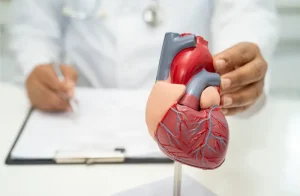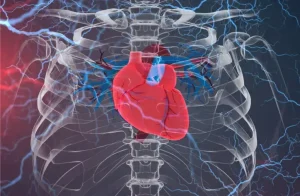When you discuss cardiovascular health, one of the most important topics that should be addressed is aortic stenosis. This condition affects millions of people worldwide and can lead to severe complications if left untreated.
This might not be a daily term, but its importance cannot be overstated. Whether you’re here out of concern for your own well-being, the health of a loved one, or simply to expand your knowledge, We invite you to engage in a conversation that could, quite literally, save lives; we will explore aortic stenosis with compassion and precision, unraveling the mysteries surrounding this condition and shedding light on its potential life-threatening implications.
What is Aortic Stenosis?
Aortic stenosis or Aortic valve stenosis is a condition characterized by the narrowing of the aortic valve in the heart. This valve plays a pivotal role in regulating blood flow from the heart to the rest of the body. When it narrows:
- Blood flow is impeded.
- The heart must work harder to pump blood.
- Over time, this can lead to serious complications.
Causes and Risk Factors
Understanding the causes and risk factors of aortic stenosis is key to prevention and early intervention. Common causes include:
- Age-related Calcification: Most common in older adults, this involves the valve becoming stiff and calcified.
- Congenital Heart Defects: Some people are born with an aortic valve that has only one or two leaflets instead of the usual three.
- Rheumatic Fever: A less common cause today, but it can result from untreated strep throat or scarlet fever.
Risk factors include:
- Age (particularly over 65)
- Smoking
- High cholesterol
- High blood pressure
- History of radiation therapy to the chest
The Deadly Progression of Aortic Stenosis
When the aortic valve narrows, it restricts blood flow from the heart to the rest of the body. Over time, this leads to severe and potentially life-threatening complications. Your doctor would classify aortic stenosis into 3 stages, from mild to severe:
- Stage 1 (Mild): The valve is narrowed but still functions efficiently. Symptoms may not be noticeable.
- Stage 2 (Moderate): The narrowing has become more significant, and the heart must work harder to pump blood. This can lead to symptoms such as chest pain, shortness of breath, and fatigue.
- Stage 3 (Severe): The valve is severely narrowed, resulting in decreased blood flow from the heart to the rest of the body. This can lead to symptoms such as fainting, dizziness, and a rapid or irregular heartbeat. Without treatment, this stage can be fatal.
How Does Aortic Stenosis Kill You?
Aortic stenosis often develops slowly over time, and its initial stages might not exhibit noticeable symptoms. However, as the condition progresses, it places increasing strain on the heart, setting the stage for potential fatal outcomes.
1- Impaired Blood Flow
The primary danger of aortic stenosis lies in its effect on blood flow. As the aortic valve narrows, it restricts the amount of blood that can flow out of the left ventricle and into the aorta. This narrowing delays the heart’s ability to pump blood efficiently, and several critical issues arise as a result:
- Increased Workload: The heart must work harder to overcome the narrowed valve and pump an adequate amount of blood.
- Left Ventricular Hypertrophy: The increased workload can cause the left ventricle to thicken and enlarge, which can eventually lead to heart failure.
2- Heart Failure
One of the most significant threats posed by aortic stenosis is heart failure. As the heart struggles to pump against the narrowed valve, it can weaken over time. Heart failure occurs when the heart can no longer pump enough blood to meet the body’s demands. This can lead to:
3- Life-Threatening Arrhythmias
Aortic stenosis can also increase the risk of life-threatening arrhythmias. Arrhythmias are abnormal heart rhythms that can lead to sudden cardiac arrest. The strain placed on the heart by aortic stenosis can disrupt the electrical signals that control the heartbeat, resulting in arrhythmias.
Aortic Stenosis In Babies
In babies, the aortic stenosis is considered to be congenital (present at birth). This generally occurs during the development of the baby’s heart in the womb. In this case, the condition can be fatal if not addressed immediately after birth. Symptoms may include:
- Poor feeding and weight gain
- Difficulty breathing
- Blue tinted skin (cyanosis)
How Long Will a Baby Live With Aortic Stenosis?
The life expectancy of a baby with aortic stenosis can vary widely depending on several factors, including the severity of the condition, the type of aortic stenosis, the age at which it is diagnosed, and the effectiveness of treatment. Here are some key considerations:
- Severity of Aortic Stenosis: The degree of narrowing in the aortic valve or artery is a critical factor. Mild cases may have a better prognosis compared to severe cases.
- Type of Aortic Stenosis: The specific type of aortic stenosis (valvular, subvalvular, or supravalvular) can influence the outlook. Some types may respond better to treatment than others.
- Age at Diagnosis: Early diagnosis and intervention are essential. Babies who are diagnosed and treated promptly have a better chance of improved outcomes.
- Treatment Options: The effectiveness of treatments such as balloon valvuloplasty or surgery can significantly impact life expectancy. Successful procedures can lead to improved heart function and a longer life.
- Response to Treatment: The baby’s response to treatment is a crucial factor. Some infants may respond well to interventions, while others may require ongoing medical management.
- Underlying Health Conditions: The presence of other congenital heart defects or medical conditions can complicate the prognosis.
It’s important to note that advancements in pediatric cardiology and cardiac surgery have improved the outcomes for infants with aortic stenosis. Many babies with this condition can lead fulfilling lives with appropriate medical care. However, each case is unique, and it is essential for parents and caregivers to work closely with pediatric cardiologists to develop a personalized treatment plan and understand the specific prognosis for their child.
Aortic stenosis is diagnosed through a combination of medical history assessment, physical examination, and various diagnostic tests. Here’s a breakdown of the typical diagnostic process:
Medical History and Physical Examination:
The healthcare provider will begin by taking a detailed medical history, which includes asking about symptoms, family history of heart disease, and any relevant medical conditions.
A physical examination is performed to assess the patient’s overall health and gather clues about the presence of aortic stenosis. Key findings during the exam may include a heart murmur (an abnormal heart sound) and other signs such as chest pain, shortness of breath, or fatigue.
Echocardiogram (Echo):
An echocardiogram is the primary imaging test used to diagnose aortic stenosis. It is a non-invasive ultrasound of the heart that provides detailed images of the heart’s structures, including the aortic valve.
During an echo, the size and function of the aortic valve, as well as the velocity of blood flow through the valve, are assessed. This test helps determine the severity of the stenosis.
Electrocardiogram (ECG or EKG):
An electrocardiogram records the electrical activity of the heart. It can help identify abnormal heart rhythms and provide information about the overall health of the heart.
Chest X-ray:
A chest X-ray may be performed to visualize the heart and lungs. While it does not directly diagnose aortic stenosis, it can provide information about the size and shape of the heart and any associated lung congestion.
Cardiac Catheterization (In Some Cases):
Cardiac catheterization is an invasive procedure that involves inserting a thin, flexible tube (catheter) into a blood vessel and guiding it to the heart. It is typically reserved for cases where additional information is needed or if a valve replacement procedure is being considered.
Other Tests:
In some cases, additional tests such as a stress test or a cardiac MRI (Magnetic Resonance Imaging) may be used to evaluate the heart’s function and the severity of aortic stenosis.
Final Words
In Conclusion, aortic stenosis is a severe condition that can be life-threatening if left untreated. In babies, early diagnosis and intervention are critical for improved outcomes. Parents and caregivers should work closely with their healthcare providers to develop a personalized treatment plan and understand the specific prognosis for their child. With advancements in medical technology and treatments, many children with aortic stenosis can lead fulfilling lives.
If you or your child is experiencing any symptoms of aortic stenosis, seek medical attention promptly to ensure proper diagnosis and treatment. Get in touch with Atlantic Cardiovascular’s seasoned cardiologists for further help. We are here to support you and guide you through every step of your journey towards better heart health. Remember, knowledge is power, so stay informed and take care of your heart!






